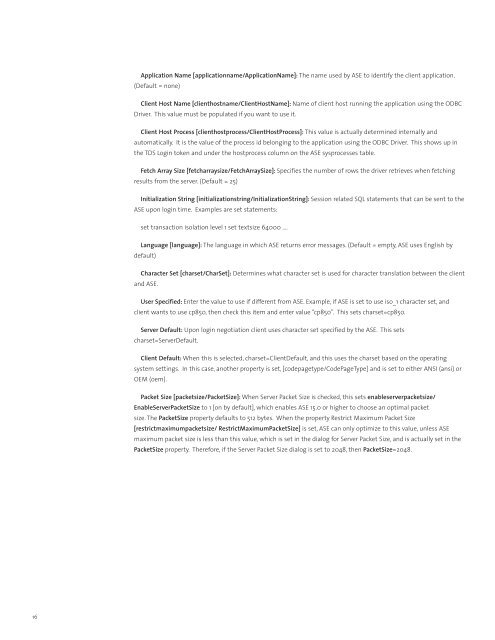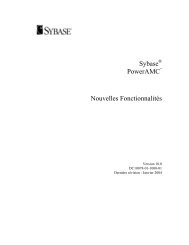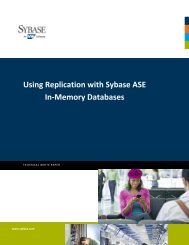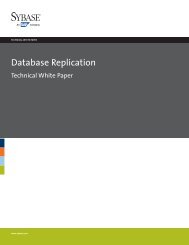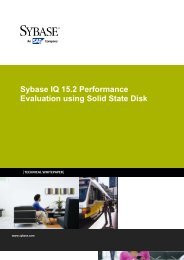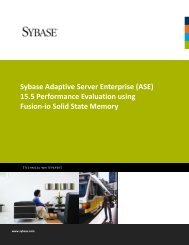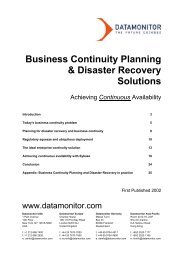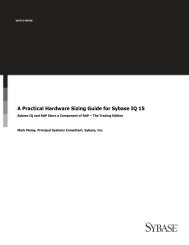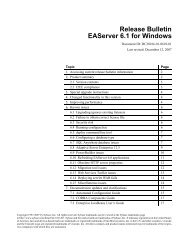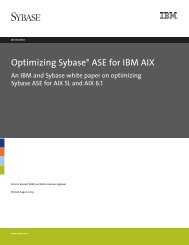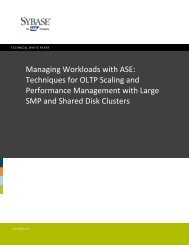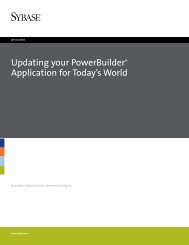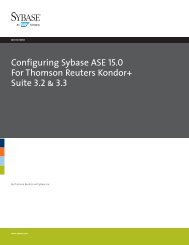ASE ODBC Driver and OLE DB Provider Migration Technical - Sybase
ASE ODBC Driver and OLE DB Provider Migration Technical - Sybase
ASE ODBC Driver and OLE DB Provider Migration Technical - Sybase
You also want an ePaper? Increase the reach of your titles
YUMPU automatically turns print PDFs into web optimized ePapers that Google loves.
16<br />
Application Name [applicationname/ApplicationName]: The name used by <strong>ASE</strong> to identify the client application.<br />
(Default = none)<br />
Client Host Name [clienthostname/ClientHostName]: Name of client host running the application using the <strong>O<strong>DB</strong>C</strong><br />
<strong>Driver</strong>. This value must be populated if you want to use it.<br />
Client Host Process [clienthostprocess/ClientHostProcess]: This value is actually determined internally <strong>and</strong><br />
automatically. It is the value of the process id belonging to the application using the <strong>O<strong>DB</strong>C</strong> <strong>Driver</strong>. This shows up in<br />
the TDS Login token <strong>and</strong> under the hostprocess column on the <strong>ASE</strong> sysprocesses table.<br />
Fetch Array Size [fetcharraysize/FetchArraySize]: Specifies the number of rows the driver retrieves when fetching<br />
results from the server. (Default = 25)<br />
Initialization String [initializationstring/InitializationString]: Session related SQL statements that can be sent to the<br />
<strong>ASE</strong> upon login time. Examples are set statements:<br />
set transaction isolation level 1 set textsize 64000 ….<br />
Language [language]: The language in which <strong>ASE</strong> returns error messages. (Default = empty, <strong>ASE</strong> uses English by<br />
default)<br />
Character Set [charset/CharSet]: Determines what character set is used for character translation between the client<br />
<strong>and</strong> <strong>ASE</strong>.<br />
User Specified: Enter the value to use if different from <strong>ASE</strong>. Example, if <strong>ASE</strong> is set to use iso_1 character set, <strong>and</strong><br />
client wants to use cp850, then check this item <strong>and</strong> enter value “cp850”. This sets charset=cp850.<br />
Server Default: Upon login negotiation client uses character set specified by the <strong>ASE</strong>. This sets<br />
charset=ServerDefault.<br />
Client Default: When this is selected, charset=ClientDefault, <strong>and</strong> this uses the charset based on the operating<br />
system settings. In this case, another property is set, [codepagetype/CodePageType] <strong>and</strong> is set to either ANSI (ansi) or<br />
OEM (oem).<br />
Packet Size [packetsize/PacketSize]: When Server Packet Size is checked, this sets enableserverpacketsize/<br />
EnableServerPacketSize to 1 [on by default], which enables <strong>ASE</strong> 15.0 or higher to choose an optimal packet<br />
size. The PacketSize property defaults to 512 bytes. When the property Restrict Maximum Packet Size<br />
[restrictmaximumpacketsize/ RestrictMaximumPacketSize] is set, <strong>ASE</strong> can only optimize to this value, unless <strong>ASE</strong><br />
maximum packet size is less than this value, which is set in the dialog for Server Packet Size, <strong>and</strong> is actually set in the<br />
PacketSize property. Therefore, if the Server Packet Size dialog is set to 2048, then PacketSize=2048.


